Listening vs. Hearing
Printed Page 95
Listening and hearing are two different activities, and research affirms the importance of listening—versus merely hearing—for both public speakers and their audiences. Several studies have suggested that when people hear without actually listening, they can miss virtually all the content of oral messages (imagine the droning teacher’s voice in Charles Schulz’s Peanuts cartoons).1 Hearing means merely receiving messages in a passive way. Listening, on the other hand, means actively paying attention to what you’re hearing; it involves both processing the message to decide on its meaning and retaining what you’ve heard and understood.
To further explain this distinction, let’s briefly consider how both science and communication researchers define listening and hearing. Cognitive scientists—those who study the mind—consider listening to be a conscious mental process that includes the following components:2
- Selection (attention, perception)
- Organization (interpretation)
- Integration (storage recall)

Communication researchers define listening in a slightly different manner—with terms that describe listening as a step in the communication process:
- Sensing
- Interpreting
- Evaluating
- Responding3
Both cognitive scientists and communication researchers agree that hearing is a passive, physical activity: the act of sound waves reverberating against the eardrums, triggering messages that are sent to the brain.4 Though listening is possible once hearing begins, listening is an altogether more complicated process.5 Take the acts of watching TV versus reading a book. Whereas watching TV is a passive activity (like hearing),6 reading is a learned activity that requires information processing (like listening).7
In the following section, we further discuss listening. For the purposes of this book, we focus on two main aspects of listening: processing and retaining.